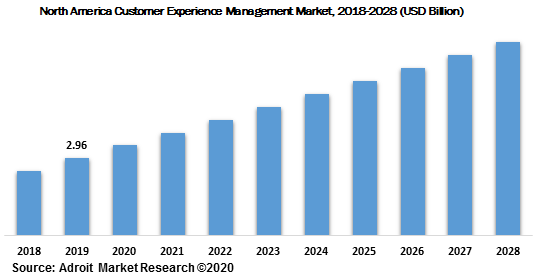The value of the Customer Experience Management market is projected to grow to USD 38.98 billion with an estimated CAGR of 18.1 % by 2030
.jpg)
The market size for the global Customer Experience Management Market is anticipated to reach USD 21.13 billion by 2028. Surging demand for personalized experience by customers across various industries is the key trend in accelerating market growth. Customer Experience Management Makrethas sets of practices and technologies to transform within organizations to meet consumer expectations.
Advancement in technologies is changing the way customer reacts and interacts with brands across channels. Currently, consumers use various devices to understand, introspect, and finalize products. This disruption in digital imaging technology has encouraged consumers to demand seamless experience while interacting with companies over various channels. Owing to the rise in customer expectations, organizations are changing their Customer Experience Management Makretstrategies to position and reposition their brands and products, keeping consumers as the strategy consulting service focus.
Customer Experience Management Market Scope
| Metrics | Details |
| Base Year | 2023 |
| Historic Data | 2018-2022 |
| Forecast Period | 2024-2030 |
| Study Period | 2018-2030 |
| Forecast Unit | Value (USD) |
| Revenue forecast in 2030 | USD 38.98 billion |
| Growth Rate | CAGR of 18.1 % during 2021-2030 |
| Segment Covered | Analytical Tools, Touch Point Type, Deployment, End-use, Regions |
| Regions Covered | North America, Europe, Asia Pacific, Middle East and Africa, South America |
| Key Players Profiled | Microfocus, Broadcom, Atlassian, Microsoft, IBM, and more. |
Key Segment Of The Customer Experience Management Market
Analytical Tools (USD Billion)
• EFM Software
• Speech Analytics
• Text Analytics
• Web Analytics & Content Management
• Others
Touch Point Type, (USD Billion)
• Stores/Branches
• Call Centers
• Social Media Platform
• Email
• Mobile
• Web Services
• Others
Deployment, (USD Billion)
• Cloud
• On-premise
End-use, (USD Billion)
• BFSI
• Retail
• Healthcare
• IT & Telecom
• Manufacturing
• Government, Energy & Utilities
• Construction, Real Estate & Property Management
• Service Business
• Others
Regional Overview, (USD Billion)
North America
• US
• Canada
Europe
• Germany
• France
• UK
• Rest of Europe
Asia Pacific
• China
• India
• Japan
• Rest of Asia Pacific
South America
• Mexico
• Brazil
• Rest of South America
Middle East and South Africa
Frequently Asked Questions (FAQ) :
Advancements in big data analytics have helped enterprise improve their end-to-end consumer experience management which drives the market. Key points of poor consumer experiences understand customer trends and have provided measurable direction to improve operational efficiencies and consumer experiences of an organization. Furthermore, increasing investments towards the implementation of advanced technologies has helped consumers undertake cognitive decisions with an effort to develop enhanced Environmental Hazard Monitoring software, and also contributing to market growth.
Touch-Point Segment
The mobile touchpoint type segment is anticipated to post highest over the forecast period. The growth of the segment can be related to the increase in the use of smartphones, which is encouraging enterprises to develop mobile marketing and communication strategies. Demand for text will remain high throughout the forecast period.
The increasing generation of text-based data in the form of feedback, and reviews across several platforms and offline survey systems is one of the factors contributing to segment growth. Text analytics tools help enterprises to understand unstructured text-based data and gain insights through social media comments and product reviews. They enable the organization to provide real-time responses and reduce manual efforts. Owing to these benefits, various number of organizations are using text analytical tools for text classification and in-depth analysis of unstructured customer data
Deployment Segment
Based on deployment, the Customer Experience Management Market has been segmented into the cloud and on-premises. The cloud-based segment is estimated to have the highest significant size in terms of revenue by 2028, Cloud technology has usage of low-cost integration of Customer Experience Management Makretsystem within the current business environment. Cloud-based Customer Experience Management Makretis accepted for its scalability and flexibility.
Organization Size Segment
The organization segment is divided into Small and Medium-sized Enterprises (SMEs). Large enterprises will have the highest market size. Large enterprises have the affordability to adopt large scale economies to deploy various Softwares.
Vertical Segment
Based on the vertical, the market is segmented Telecommunication and IT- Enabled Services, Banking, Financial Services, and Insurance, Media and Entertainment, Retail Others), Among these verticals, the healthcare vertical will grow at the highest CAGR during the forecast period. The increasing usage of smartphones to conduct transactions has enabled more personal engagement, seamless banking through the mobile channel for consumers. This trend has increased both the potential and complexity of creating a positive customer experience through management.
The global Customer Experience Management Market is a wide range to North America, Europe, APAC, South America, and the Middle East & Africa. North America will have the largest market size increase in the coming years. Furthermore, increasing marketing and digital channels among the enterprises in U.S. and Canada is another factor contributing to market growth. The market in the Asia Pacific will witness at the highest CAGR over the forecast period. The increasing adoption of IoT-based devices and sensors as well as advanced analytics tools has offered personalized services to both B2B and B2C consumers is the major factors contributing to the growth of the regional market.

The major players of the Digital Workplace Market are Microfocus, Broadcom, Atlassian, Microsoft, IBM, and more. The Customer Experience Management Market is fragmented with the existence of well-known global and domestic players across the globe

